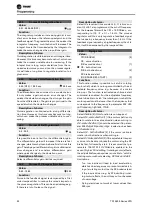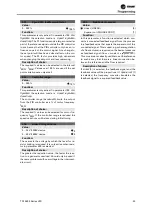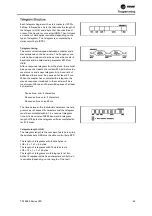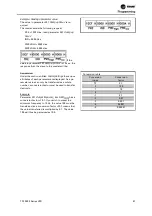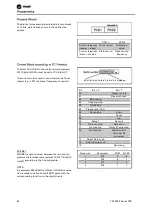
441
Process PID integration time
Value:
0.01 - 9999.99 (OFF)
OFF
Function:
The integrator provides an increasing gain at a con-
stant error between the reference/setpoint and the
feedback signal. The greater the error, the quicker the
integrator frequency contribution will increase.The
integral time is the time needed by the integrator to
make the same change as the proportional gain.
Description of choice:
Quick regulation is obtained at a short integral time.
However, this time may become too short, which can
make the process unstable due to overswing. If the
integral time is long, major deviations from the re-
quired setpoint may occur, since the process regula-
tor will take a long time to regulate in relation to a
given error.
442
Process PID differentiation time
Value:
0.00 (OFF) - 10.00 sec.
0.00 sec.
Function:
The differentiator does not react to a constant error.
It only makes a gain when an error changes. The
quicker the deviation changes, the stronger the gain
from the differentiator. The gain is proportional to the
speed at which the deviation changes.
Description of choice:
Quick regulation is obtained with a long differentia-
tion time. However, this time may become too long,
which can make the process unstable due to over-
swing.
443
Process PID diff. gain limit
Value:
5.0 - 50.0
5.0
Function:
It is possible to set a limit for the differentiator gain.
The differentiator gain will increase if there are fast
changes, which is why it can be beneficial to limit this
gain. Thereby a pure differentiator gain is obtained at
slow changes and a constant differentiator gain
where quick changes to the deviation occur.
Description of choice:
Select a differentiator gain limit as required.
444
Process PID lowpass filter time
Value:
0.02 - 10.00
0.02
Function:
Noise in the feedback signal is dampened by a first
order lowpass filter to reduce the noise's impact on
the process regulation. This can be an advantage e.g.
if there is a lot of noise on the signal.
Description of choice:
Select the required time constant (t). If a time con-
stant (t) of 0.1 s is programmed, the cut-off frequency
for the lowpass filter will be 1/0.1 = 10 RAD/sec., cor-
responding to (10 / 2 x
π
) = 1.6 Hz. The process
regulator will thus only regulate a feedback signal
that varies by a frequency lower than 1.6 Hz. If the
feedback signal varies by a higher frequency than 1.6
Hz, it will be dampened by the lowpass filter.
445
Flying start
Value:
Off
(DISABLE)
[0]
OK - same direction
(OK-same
direction)
[1]
OK - both directions
(OK-both
directions)
[2]
DC brake and start
(DC-BRAKE
BEF.
START)
[3]
Function:
This function makes it possible to 'catch' a rotating
motor shaft, which is no longer controlled by the ad-
justable frequency drive, e.g. because of a mains
drop-out. The function is activated each time a start
command is enabled. For the adjustable frequency
drive to be able to 'catch' the rotating motor shaft, the
motor speed must be lower than the frequency that
corresponds to the frequency in parameter 202
Out-
put frequency, high limit, f MAX
.
Description of choice:
Select
Disable
[0] if this function is not required.
Select
OK - same direction
[1] if the motor shaft is only
able to rotate in the same direction when cutting in.
OK - same direction
[1] should be selected if in param-
eter 200
Output frequency range
a selection has been
of
Clockwise only
.
Select
OK - both directions
[2] if the motor is able to
rotate in both directions when cutting in.
Select
DC brake and start
[3] if the adjustable frequen-
cy drive is to be able to brake the motor using the DC
brake first, followed by start. It is assumed that pa-
rameters 126-127/132
DC brake
are enabled. In the
case of higher 'Windmilling' (rotating motor) effects,
the adjustable frequency drive is not able to 'catch' a
rotating motor without selecting
DC brake and start
.
Limitations:
-
Too low inertia will lead to load acceleration,
which can be dangerous or prevent correct catch-
ing of a rotating motor. Use the DC brake instead.
-
If the load is driven, e.g. by 'Windmilling' (rotat-
ing motor) effects, the unit may cut out because
of overvoltage.
-
Flying start does not work at lower values than
250 rpm.
52
TR1
2800
Series
VFD
Programming
Summary of Contents for VarioTrane TR1 2800 Series
Page 2: ...T TR R1 1 2 28 80 00 0 S Se er ri ie es s V VF FD D 1 1...
Page 3: ...2 2 T TR R1 1 2 28 80 00 0 S Se er ri ie es s V VF FD D...
Page 4: ...TR1 2800 Series VFD 3...
Page 7: ...6 TR1 2800 Series VFD...
Page 87: ...Illustration 5 7 192H4719 Illustration 5 8 192H4720 86 TR1 2800 Series VFD...
Page 95: ...Branch Circuit Protection Short circuit protection 94 TR1 2800 Series VFD...
Page 107: ...All about TR1 2800 Series VFD 106 TR1 2800 Series VFD...















